#3D Motion Capture Software
Explore tagged Tumblr posts
Text
looking through the dual destinies and spirit of justice sprites really has me like "did ace attorney have a rough transition to 3d or do some of the sprite animations just not work in 3d like they do 2d"
#yes theres a difference. “rough transition to 3d” generally means the entire game is messy#additionally usually “rough transition to 3d” implies they couldn't help how the 3d stuff turned out#100% convinced that if they hadn't stuck to some of the 2d sprite animations it wouldn't be QUITE as awkward as it is#not all the sprites in dd and soj are awkward either. they just decided to keep the 2d sprite animations#for some characters that works (ema and trucy for example) but for others (APOLLO) it feels SO awkward on some animations#klavier. i just hate klavier's model. i love his animations though lol. his hair flip after his laughing animation? 10/10#the other issue is that dual destinies and spirit of justice feel like they were animated using a regular 3d animation software#im 100% convinced that the reason the animation on tgaa's sprites is so nice in comparison is because they used motion capture#i dont know if dd and/or soj used mocap but it feels like they didnt and i think its one of the issues with the sprites#most of the designs arent any more or less realistic than tgaa's designs. mocap would work for dd and soj's sprites#anyway enjoy in-the-tags the ramblings about the sprites of a game i havent played yet lmao#ace attorney#dual destinies#spirit of justice#ramble in the tags
15 notes
·
View notes
Text

The "Mario In Real-Time" engine allowed Charles Martinet and other voice actors to project their movements onto a 3D floating Mario head using motion capture at live shows to interact with the audience as Mario. The footage shows it in action at the 1992 Summer Consumer Electronics Show.
The earliest iterations of the engine did not have protective measures against the head clipping into the camera. As such, when the voice actor tilted his head forward too far, Mario would pass through the screen so that the inside of his head was visible, as seen in the footage. This was fixed in the later versions of the software.
Main Blog | Patreon | Twitter | Bluesky | Small Findings | Source: DigitalNeohuman
1K notes
·
View notes
Note
How do you do your model capture for twitch?
I use a Logitech C930e webcam (not the most ideal option but it is a good affordable one) and VSeeFace (there's a lot of 3D Vtubing software out there that gives a loooot more options for Gimmicks n shit but honestly I don't feel like learning how they work sahfghafj) and a Leap Motion hand tracker for my hands (I tried using a Leap Motion 2, it was Actively Worse)
One little thing I wanna say while we're on the topic, regardless of your Vtuber software, if you feel your mouth tracking doesn't look right, try turning down mouth sync smoothing (or whatever similar name it has in the program in question.) Mouth sync smoothing means the mouth will take longer to transition between the sounds you make, meaning it can't keep up with normal talking speed and doesn't actually mimic your mouth properly.
28 notes
·
View notes
Text
Link! Like! LoveLive! SPECIAL STAFF INTERVIEW
[This interview was published online on the G's Channel website, and is print in the Link! Like! LoveLive! FIRST FAN BOOK, released Dec 27, 2023.]
The Hasunosora Jogakuin School Idol Club is a group of virtual school idols that made their striking debut in April this year. How did their fan engagement app “Link! Like! LoveLive!” come about? Fujimoto Yoshihiro and Sato Kazuki discuss the app’s origin and what they think about the project.
It’s all about enjoying Love Live!—! The untold story behind the birth of the fan engagement app LLLL
—The smartphone app “Link! Like! LoveLive!” (which we’ll refer to as “LLLL”), celebrated its six-month anniversary in November. Let’s look back on the past six months and discuss the birth of LLLL. To start us off, could you two tell us about your roles in developing this app?
Sato: I’m Sato Kazuki from CERTIA, a producer for this app. I’ve worked for game companies as a planner and director, and now I’m a self-directed game producer. From arcade games to consumer software to apps, my path has involved a variety of media. I’ve been following Love Live! as a fan since the µ’s era, and became a producer for Hasunosora’s game after being consulted for a Love Live! app where the members stream.
Fujimoto: I’m Fujimoto Yoshihiro from Bandai Namco Filmworks, and I’m also a producer for LLLL. I started with the desire to make a Love Live! smartphone game.
***
—LLLL’s official start of service was May 20, 2023, but I heard that the road there was quite long. Could you talk about that?
Fujimoto: If we want to start from when development began…. we’ll have to go back to 5 years ago.
Sato: A big part of the appeal of Love Live! comes from these school idols being independent and putting their souls into it as a club activity, so there is a certain kind of enjoyment and emotional payoff from supporting them.
If you insert a “player” who can essentially play god into this, it inevitably feels like a mismatch. Then wouldn’t it be great to turn that idea on its head and instead have an app where you support these independent idols? And streaming would be a great match for that. As we worked out this concept where you cheer on the members as just another fan, this “school idol fan engagement app” took form.
—What led up to integrating motion capture into the app?
Sato: From the very beginning, we had decided that virtual concerts and streams would use 3D models. The development team already had the know-how for streaming with 3D models, so of course we were going to use them.
The key idea is to have the virtual concerts, live streams, and story intimately linked to make the entire experience real-time, so we decided it would be best to have them appear in the same form in both the streams and the activity log (story), which is why the story also uses 3D models. The visuals should be precisely linked so we carefully animated the story with 3D models.
Fujimoto: It is quite rare for the cast to also do motion capture, but it was necessary to realize the vision that Sato-san has described. Yes, it would technically be doable to have the cast only voice the characters and instead have actors do the motion capture, but that would be a lot less palatable.
Sato: It certainly feels a lot more real when the cast is both voicing and moving their characters. The fact that this project is a part of the Love Live! series helped a lot in being able to implement this. The cast loves Love Live!, and it’s because of how much the project staff and cast members put into this that we could make it a reality.
—As an example of this hard work: the cast had intense training on motion and talking, with lessons and rehearsals starting about a year before the app was released.
Sato: In both the live streams and virtual concerts, the cast do the motion capture, in real-time too! Even now, this fact isn’t well-known, or rather, it seems like there are a lot of people who think “No way they go that far!”. Yes, the cast do it themselves!
—So why does doing it in real-time make it good?
Sato: What a pointed question! (laughs)
Fujimoto: What’s important depends on what you value. What we’re aiming for is the feeling of a real concert.
Sato: Putting it concisely, the feeling that it’s live is very important to LLLL. It seems to me that the feeling of being live has recently been highly valued, not just in concerts but in the entertainment industry as a whole. We can look back on works of the past whenever we want through subscription services and the like, so following something now has its own appeal that can evoke a certain zeal. Bearing witness to this moment in history is now viewed as being more significant than it used to be. That’s why we maximize that feeling of being live by having the cast do the motion capture and by streaming in real-time. We felt that those two points are essential.
—So rather than just being parts of the concept, these are essential to the project.
Sato: At one point, we considered doing only the talk and MC in real-time, while having the performance part be recorded. But because we want to get at the heart of the pleasure of having it be real-time, we couldn’t make that compromise.
Actually, the cast do occasionally hit the wrong notes or mess up their dance formations, but these are little things that signal that it’s live—in fact, such happenings can increase how real it feels, which can make the performance feel special if you approach it with the right mindset.
***
—Can I ask about the Fes×LIVE production, like the camerawork, lighting, and outfits? It feels like the production value goes even higher every time.
Fujimoto: I think that’s probably because, just like how the Hasunosora members are growing, the staff is as well, going further each time after saying things like “For the next performance, I want more of this!”.
Sato: Things like flying over the stage or swapping outfits in the instant that the lighting changes—we won’t do those. A core principle is that we aim for a production that matches what school idols would do and constrain ourselves to portray what’s possible in reality.
***
—The story following school idols at a school steeped in tradition—that’s a new challenge, too.
Sato: We had certain reasons for setting this at a school with a long history—so long that this year is the 103rd. There’s this common image of streamers debuting as no-names, and then working their way up to become more popular. But if Hasunosora were like that, the fact that there would be a lot of fans from the beginning would make it very unrealistic. After all, there’s no way your average rookie streamer could be like “This is my first stream!” and yet have 5000 viewers. (laughs)
We thought hard about how to resolve this in a way that makes sense. Then, we figured out that it would work to have a tradition-laden school that was already a “powerhouse”. So in the end, we made it a point to have the school be a powerhouse with a history of having won Love Live! before.
—So the school already had fans following it, with high expectations for the new school idols: Kaho and the other first years.
Sato: Yeah, it’s meant to be like one of those schools that are regular contenders at Koshien, the national high school baseball championship.
—The world-building is done so thoroughly that such an answer could be arrived at pretty quickly.
Sato: We consulted with many people, starting with the writer team, about implementing the concepts that we mentioned before—having the cast do motion capture to maximize the live feeling, and doing the streams in real-time.
In the beginning, there was a lot of resistance to the idea of trying to successfully operate an app while constructing the story and streams such that there would be no contradictions between them. If you do streams in real-time, such contradictions can certainly arise—you have to work out the setting in quite a lot of detail, and even then, things can happen that are impossible to predict.
But my thinking was always that this is doable if we adjust how often we synchronize the story and streams. I think it’s impossible to stream every day and release a new story every day. But on the other side of the spectrum, if we were to write a year’s worth of story ahead of time, and then do however many streams within that year, that would certainly be doable.
Following that line of thought, in the early stages, we had a lot of discussion about how often we could do streams, searching for the limit of what would be possible to implement. As a compromise, we arrived at the system of fully synchronizing once a month. For each month, we can keep the setting relatively flexible, not setting everything precisely in stone until the month is over. We thought that a monthly frequency should make it possible to both maintain the charm of the story and implement streams.
But right now we’re streaming three times a week, so there end up being a lot of things like “they shouldn’t know this yet” or “this event hasn’t happened yet”. It feels like putting together a complicated puzzle.
Fujimoto: There’s one aspect that we haven’t made clear before—I don’t think there are many people that have realized it. It’s that the talk streams are the furthest along in the timeline, while the story shows what has already happened. It’s not that the story happens on the day that we update it, but rather that the story describes what happened up to that day. People who have realized this have probably read quite closely.
Sato: That’s why it’s called the “activity log”. The With×MEETS serve the important role of synchronization between what happened in the activity log—the world of the story—with reality, so we carefully prepare for them each time.
—That makes sense! One nice thing is that if you keep up with the With×MEETS in real-time, then watch the Fes×LIVE, it feels like keeping up paid off—”Good thing I watched the With×MEETS!”.
Fujimoto: It would be great if our efforts got through to everyone enjoying LLLL.
—If you set things up that carefully, it must be difficult when irregularities happen. In August, several cast members had to take a break to recover from COVID-19, causing many With×MEETS to be canceled. How did you deal with that?
Sato: The silver lining of that period was that it avoided the most critical timing. If that had been off by even a week… it might not have been possible to recover from that. This project always has this feeling of tension, because there is no redoing things.
***
Tackling the Love Live! Local Qualifiers! The culmination of the story put viewers on the edges of their seats!!
—On how people have reacted to LLLL: was there anything that went exactly as planned, and on the other hand, was there anything that defied your expectations?
Fujimoto: To bring up a recent event, the Love Live! Local Qualifiers in October very much stood out. There was tension all around—even I was nervous about how it would go. The feeling that “these girls really are going to take on this challenge, at this very moment”. It was like watching the championship of the World Baseball Classic… Well, maybe that’s an overstatement, but an atmosphere similar to that. I’m really happy that we managed to create such an atmosphere with the cast and everyone who participated as a user.
Sato: Not just in sports, but also in the world of anime or fiction, there is definitely a certain excitement that arises when you “witness” something. Bearing witness to the moment that “drama” is born produces an impulse, something that hits deep. This is not something that can be produced in an instant. Rather, such an overwhelming concentration of passion can come about only because so much has happened up to that point.
That’s why, aiming for “that moment”, we first have people experience the Hasunosora members’ existence and reality day after day. After having connected with the members and viscerally felt the sense of being in sync with their “now”, something new will be born…
The closest we’ve gotten to an atmosphere of tension that’s as close as possible to the real thing is what Fujimoto-san just mentioned, the Love Live! Local Qualifiers. I think part of why that was such an “incredible” event was the weight of everything that happened in the Love Live! series up to that point.
—Is there anything else from the fans’ reactions and the like that was unexpected?
Fujimoto: For the talk streams, we have a system where everyone can write comments in real-time. Some users go all in on the setting and act as if they’re in that world.
Sato: The characters are not aware that their everyday lives can be observed in the story, so these users adhere to the rule of not talking about anything that’s only depicted in the story, commenting as if they don’t know what happened there. And if you do that, your comment might get read. So you really can be a participant in the performance. We were surprised at just how many people were earnestly participating like that.
—It’s like making a fan work in real-time, or rather, it’s like playing a session of a tabletop RPG.
Sato: I think what we’re doing here is very much like a game. It’s the “role-playing” of a tabletop RPG taken to an extreme, a pillar of a certain kind of “game”, or maybe more like a participatory form of entertainment.
—Oh, I see! It’s as if we’ve returned to the classic reader participation projects of Dengeki G’s magazine, which is kind of touching.
[Translator’s note: Love Live! originated from Sunrise collaborating with the Dengeki G’s magazine editorial department, bringing Lantis in for music.]
Sato: Yes, indeed. In the era of magazine participatory projects, the back-and-forth would have several months in between. In comparison, a real-time system makes it easier to participate, which I think is a significant and useful advancement. For now, in the first year, it feels like we’ve been grasping in the dark while trying to do the best with what we have. But we’re thinking about how best to adjust the frequency and volume of activities from here on.
Fujimoto: Also, the users have largely figured out all the hints we cooked in!
Sato: They’ve been looking in quite some detail. (laughs) Our cooking has paid off.
***
—Is there any challenge that LLLL is taking on anew?
Sato: Going back to what I said at the beginning, I was a huge fan of µ’s, so I started by trying to analyze and put into words just what made me so attracted to, so crazy about them.
A big part of the charm was that it involved youth and a club activity, so by following their story and cheering them on, you could vicariously re-live the passion of those three years in high school. So I wanted to make it so that you could re-live that experience of youth in depth.
My goal is to have it feel so overwhelmingly real—through LLLL’s real-time nature—that you can unwittingly delude yourself into the sense that you’re re-living your high school years.
Fujimoto: If we’re talking about a new challenge, maybe it’d be good to touch on how frequent the interactions are.
For example, let’s consider a one-cour anime. No matter how much you’d like to keep watching it, it ends after three months. Even if it turns out there’s a continuation, you’ll have to wait before you can watch that.
In contrast, if we turn to virtual content, people are streaming three times a week on YouTube. In that vein, what we’re aiming for with this project is this: you can follow this group you like throughout that limited time between matriculation and graduation, and during that time they’ll always be there for you to meet.
***
—Some people are expecting an anime as one of the future mixed-media developments. To put it bluntly, what do you think about that?
Sato: What we are doing right now with Hasunosora would not work outside the structure of an app. As mentioned before, it’s not quite a tabletop RPG but rather a participatory form of entertainment, and it’s that structure that allows fans to experience the true spirit of the Hasunosora Jogakuin School Idol Club.
—So for now, we should experience it through the streams in the app! Is that what you’re saying?
Fujimoto: Exactly. It wouldn’t be an exaggeration to say that LLLL is a project to make you fall for these girls throughout their streams—that’s how much effort we’re putting into it.
Sato: Starting LLLL by going through the story and then participating in the With×MEETS streams might be more common, but you can also start enjoying it in a novel way by just jumping into the latest With×MEETS stream. The members’ engagement with the comments has been especially noticeable in the most recent streams—it feels like a symbiotic relationship.
***
—Finally, a word for those who are looking forward to the project’s future.
Sato: I can confidently say that LLLL is a new experience made possible because of the times we live in. Because of that, it is very high-context, so it’s hard to explain how it will make you feel or what kind of game it is—you must play it to understand. We are very aware of how much of a hurdle this is, and how it might be difficult to get a grasp on if you start later.
But if you’re willing to take that first step into the world of LLLL, we promise to bring you content that is worth following. So to those reading this interview: please do consider trying it out once, even if it’s with a window-shopping mindset.
Fujimoto: Hasunosora’s story can only happen because of everyone watching. We hope you’ll keep supporting us!
Sato: We’ve prepared plenty of tricks up our sleeves for the end of the school year in March, so please look forward to it!
Credits
Translation: ramen Translation check: xIceArcher Various suggestions: Yahallo, Yujacha, zura
44 notes
·
View notes
Text
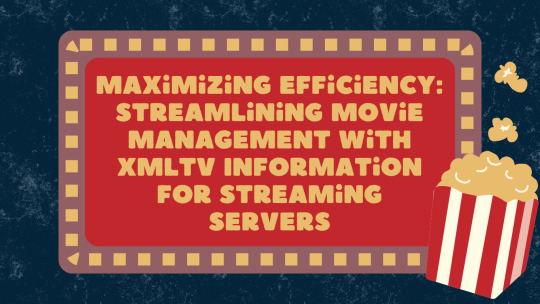
Effective XMLTV EPG Solutions for VR & CGI Use
Effective XMLTV EPG Guide Solutions and Techniques for VR and CGI Adoption. In today’s fast-paced digital landscape, effective xml data epg guide solutions are essential for enhancing user experiences in virtual reality (VR) and computer-generated imagery (CGI).
Understanding how to implement these solutions not only improves content delivery but also boosts viewer engagement.
This post will explore practical techniques and strategies to optimize XMLTV EPG guides, making them more compatible with VR and CGI technologies.
Proven XMLTV EPG Strategies for VR and CGI Success
Several other organizations have successfully integrated VR CGI into their training and operational processes.
For example, Vodafone has recreated their UK Pavilion in VR to enhance employee training on presentation skills, complete with AI-powered feedback and progress tracking.
Similarly, Johnson & Johnson has developed VR simulations for training surgeons on complex medical procedures, significantly improving learning outcomes compared to traditional methods. These instances highlight the scalability and effectiveness of VR CGI in creating detailed, interactive training environments across different industries.
Challenges and Solutions in Adopting VR CGI Technology
Adopting Virtual Reality (VR) and Computer-Generated Imagery (CGI) technologies presents a set of unique challenges that can impede their integration into XMLTV technology blogs.
One of the primary barriers is the significant upfront cost associated with 3D content creation. Capturing real-world objects and converting them into detailed 3D models requires substantial investment, which can be prohibitive for many content creators.
Additionally, the complexity of developing VR and AR software involves specialized skills and resources, further escalating the costs and complicating the deployment process.
Hardware Dependencies and User Experience Issues
Most AR/VR experiences hinge heavily on the capabilities of the hardware used. Current devices often have a limited field of view, typically around 90 degrees, which can detract from the immersive experience that is central to VR's appeal.
Moreover, these devices, including the most popular VR headsets, are frequently tethered, restricting user movement and impacting the natural flow of interaction.
Usability issues such as bulky, uncomfortable headsets and the high-power consumption of AR/VR devices add layers of complexity to user adoption.
For many first-time users, the initial experience can be daunting, with motion sickness and headaches being common complaints. These factors collectively pose significant hurdles to the widespread acceptance and enjoyment of VR and AR technologies.
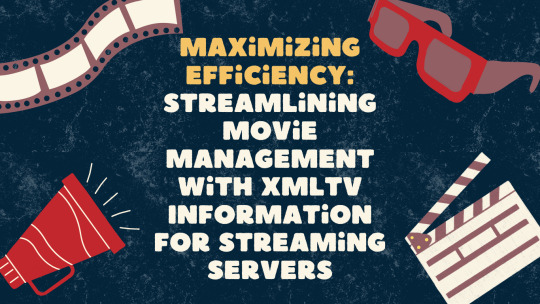
Solutions and Forward-Looking Strategies
Despite these hurdles, there are effective solutions and techniques for overcoming many of the barriers to VR and CGI adoption.
Companies such as VPL Research is one of the first pioneer in the creation of developed and sold virtual reality products.
For example, improving the design and aesthetics of VR technology may boost their attractiveness and comfort, increasing user engagement.
Furthermore, technological developments are likely to cut costs over time, making VR and AR more accessible.
Strategic relationships with tech titans like Apple, Google, Facebook, and Microsoft, which are always inventing in AR, can help to improve xmltv guide epg for iptv blog experiences.
Virtual Reality (VR) and Computer-Generated Imagery (CGI) hold incredible potential for various industries, but many face challenges in adopting these technologies.
Understanding the effective solutions and techniques for overcoming barriers to VR and CGI adoption is crucial for companies looking to innovate.
Practical Tips for Content Creators
To optimize the integration of VR and CGI technologies in xmltv epg blogs, content creators should consider the following practical tips:
Performance Analysis
Profiling Tools: Utilize tools like Unity Editor's Profiler and Oculus' Performance Head Hub Display to monitor VR application performance. These tools help in identifying and addressing performance bottlenecks.
Custom FPS Scripts: Implement custom scripts to track frames per second in real-time, allowing for immediate adjustments and optimization.
Optimization Techniques
3D Model Optimization: Reduce the triangle count and use similar materials across models to decrease rendering time.
Lighting and Shadows: Convert real-time lights to baked or mixed and utilize Reflection and Light Probes to enhance visual quality without compromising performance.
Camera Settings: Optimize camera settings by adjusting the far plane distance and enabling features like Frustum and Occlusion Culling.
Building and Testing
Platform-Specific Builds: Ensure that the VR application is built and tested on intended platforms, such as desktop or Android, to guarantee optimal performance across different devices.
Iterative Testing: Regularly test new builds to identify any issues early in the development process, allowing for smoother final deployments.
By adhering to these guidelines, creators can enhance the immersive experience of their XMLTV blogs, making them more engaging and effective in delivering content.
Want to learn more? You can hop over to this website to have a clear insights into how to elevate your multimedia projects and provide seamless access to EPG channels.
youtube
7 notes
·
View notes
Text
VTUBER SOFTWARES
XR Animator DL
Full body tracking via webcam.
Able to use props.
Able to import motion data files.
Able to import videos to render motion data.
Able to pose.
Able to export the data via VMC to VSeeFace or any other applications.
VRM Part Adder DL
Able to attach props to VRM file without using Unity.
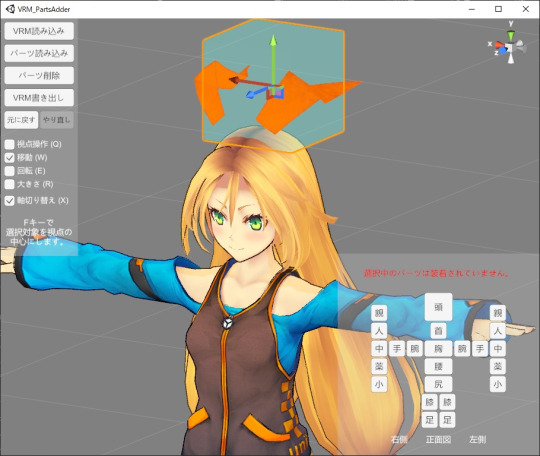
Texture Replacer DL
Able to fix textures of the said props if they are missing.
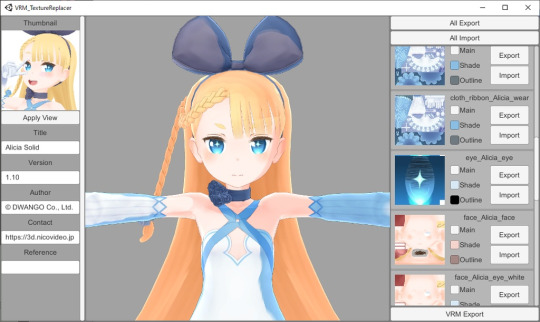
Hana App DL
Able to add 52 blendshapes for PerfectSync without using Unity.

VNyan DL
VNyan is an 3D animating software.

VtubeReflect DL
VtubeReflect captures your desktop and projects light onto your vtuber avatar.
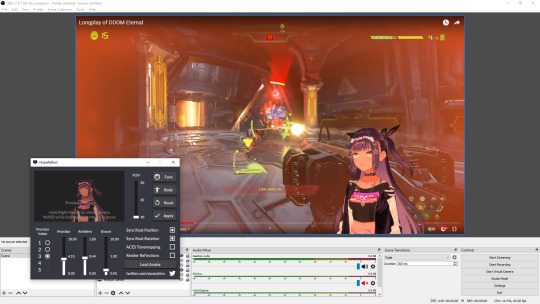
Craft2VRM DL
Use Minecraft skin as a vtuber model.
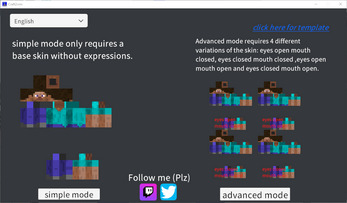
Dollplayer DL
Able to pose VRM.

ThreeDPoseTracker DL
Able to generate motion data based on video.
VDraw DL
Able to show drawing and using keyboard animation through VRM.
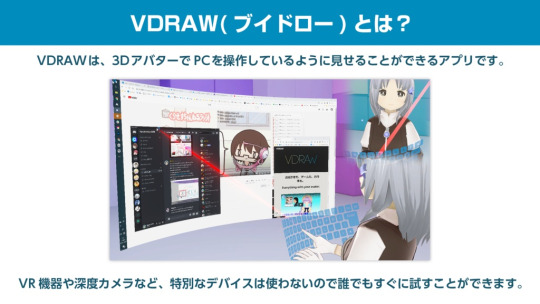
VMagicMirror DL
Able to show drawing and using keyboard animation through VRM.
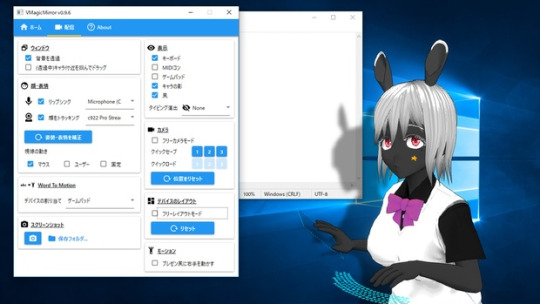
Virtual Motion Capture DL
Track avatar movement through VR.
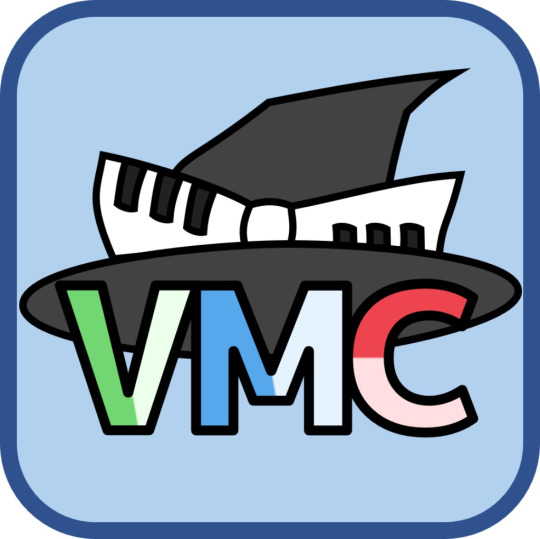
Mechvibes DL
One of the only free applications that'll let you to change the sound of your keyboard into anything!

Gigapixel DL
Picture upscaler.
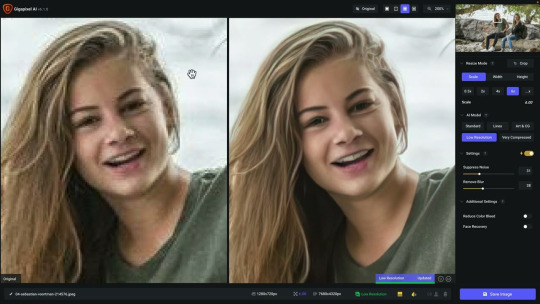
Clipchamp DL
Free text-to-speech tools.
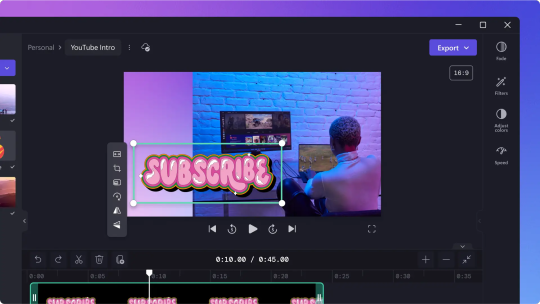
Rekonise LINK
Content creator tools.
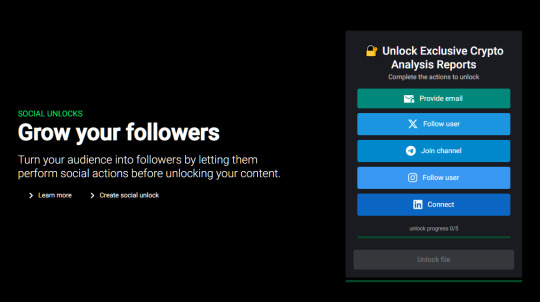
VRoom LINK
Places your VRM in a world.
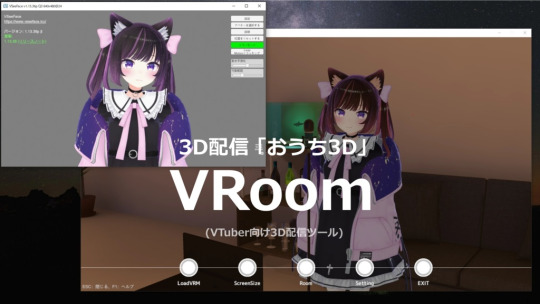
VRM games LINK
List of games/applications that allow the import of VRM.
4 notes
·
View notes
Text
^ it's extremely extremely funny that none of this is proved at all, it's just people's gut feelings (no, that Microsoft paper supposedly proving the decline of critical thinking due to AI does not say what you think it says! if you believe this, you have been bamboozled!)
some of you will go "erm, it's fancy autocomplete" but also "erm, you are hurting yourself by using it, it's a special kind of evil tool that isn't a tool, for reasons" and then developers like me will say "we had fancy autocomplete like IntelliSense for years now and we're fine, what's GitHub Copilot going to do? make our code worse than the noble tradition of copypasting from StackOverflow?"and the only thing we get in response is misinformation, fearmongering or a blank stare.
there are entire creative subcultures that just simply don't share your romantic, extremely American Protestant view of struggling. there's widely-spread programmer wisdom about the virtues of laziness! the reason you can play so many wonderful indie games today is because the glorious art of struggling to code your own physics system has been automated by game engines.
reducing the amount of struggling so you can move on to more personally-appealing and valuable decision-making is in fact an entire part of the human experience. sorry that you don't value this, but i am not learning how to make my own physics system in order to make games with physics in them, for the same reason i am not learning how to draw to make games with drawings in them. it just doesn't appeal to me, and the idea that i'm harming myself as a result
all in all, your protesting is completely indistinguishable from past movements complaining about the destruction of creative/critical-thinking skills, with absolutely no actual evidence, based solely on fear and the age-old belief that kids these days are so much stupider than you and civilization is crumbling.
all the contemptible fossils that came before you yelling This Technology Is Monstrously Harmful To Your Growth As A Human Bean about writing, the printing press, photography, personal computers, calculators, phones, digital art software, 3D modeling, motion capture, drum machines, synthesizers, the internet, wikipedia, stackoverflow, etc etc etc etc., surely these guys were wrong, but you're right and this time history will validate you! surely this time! for sure!
Something I don't think we talk enough about in discussions surrounding AI is the loss of perseverance.
I have a friend who works in education and he told me about how he was working with a small group of HS students to develop a new school sports chant. This was a very daunting task for the group, in large part because many had learning disabilities related to reading and writing, so coming up with a catchy, hard-hitting, probably rhyming, poetry-esque piece of collaborative writing felt like something outside of their skill range. But it wasn't! I knew that, he knew that, and he worked damn hard to convince the kids of that too. Even if the end result was terrible (by someone else's standards), we knew they had it in them to complete the piece and feel super proud of their creation.
Fast-forward a few days and he reports back that yes they have a chant now... but it's 99% AI. It was made by Chat-GPT. Once the kids realized they could just ask the bot to do the hard thing for them - and do it "better" than they (supposedly) ever could - that's the only route they were willing to take. It was either use Chat-GPT or don't do it at all. And I was just so devastated to hear this because Jesus Christ, struggling is important. Of course most 14-18 year olds aren't going to see the merit of that, let alone understand why that process (attempting something new and challenging) is more valuable than the end result (a "good" chant), but as adults we all have a responsibility to coach them through that messy process. Except that's become damn near impossible with an Instantly Do The Thing app in everyone's pocket. Yes, AI is fucking awful because of plagiarism and misinformation and the environmental impact, but it's also keeping people - particularly young people - from developing perseverance. It's not just important that you learn to write your own stuff because of intellectual agency, but because writing is hard and it's crucial that you learn how to persevere through doing hard things.
Write a shitty poem. Write an essay where half the textual 'evidence' doesn't track. Write an awkward as fuck email with an equally embarrassing typo. Every time you do you're not just developing that particular skill, you're also learning that you did something badly and the world didn't end. You can get through things! You can get through challenging things! Not everything in life has to be perfect but you know what? You'll only improve at the challenging stuff if you do a whole lot of it badly first. The ability to say, "I didn't think I could do that but I did it anyway. It's not great, but I did it," is SO IMPORTANT for developing confidence across the board, not just in these specific tasks.
Idk I'm just really worried about kids having to grow up in a world where (for a variety of reasons beyond just AI) they're not given the chance to struggle through new and challenging things like we used to.
#tech#ai#i am getting tired of this shit#so many artists going “i don't want to draw backgrounds so i stole a photograph off google images” “this is acceptable!”#and simultaneously “AI IS DESTROYING YOUR CAPABILITIES”. absolute goofball behavior
38K notes
·
View notes
Text
How Drone Mapping is Saving Time and Money on LA Construction Sites
In the fast-paced world of Los Angeles development, efficiency and accuracy are more critical than ever. As construction projects grow in complexity and scale, technology has stepped in to bridge the gap between planning and execution. One of the most impactful tools revolutionizing the industry is construction site drone surveillance. At Petrossian Aerial, we use advanced drone mapping solutions to help contractors, engineers, and developers save time, reduce costs, and streamline project management with high-resolution data captured from above.
The Need for Speed and Precision in LA Construction
Los Angeles is a city in constant motion. With ever-growing residential, commercial, and infrastructure demands, construction teams must meet tight deadlines while maintaining quality and compliance. Traditional methods of surveying and monitoring can be time-consuming, costly, and prone to error. Drone mapping offers a faster, safer, and more accurate alternative — allowing stakeholders to view, analyze, and make decisions based on real-time, high-definition aerial data.
Drone mapping uses a fleet of high-tech drones equipped with LiDAR, GPS, and photogrammetry software to create 2D orthomosaics and 3D models of active construction sites. These maps offer centimeter-level accuracy and are ideal for tracking site progress, inspecting work quality, verifying measurements, and identifying potential safety hazards — all without setting foot on the ground.
Benefits of Drone Mapping for LA Construction Projects
Faster Project Assessments Drone mapping can survey a large construction site in a matter of hours — a task that may take traditional survey crews days. This accelerated data collection helps project managers make quicker decisions and keep projects on schedule.
Improved Accuracy and Documentation High-resolution aerial maps generated by drones are far more detailed than satellite imagery or handheld photos. These maps allow teams to track changes over time, compare progress to architectural plans, and document key milestones for future reference or legal compliance.
Enhanced Safety Construction sites can be hazardous, especially in urban areas like LA with multiple trades working simultaneously. Drones reduce the need for on-foot inspections, keeping workers out of harm’s way while still capturing critical site data from above.
Cost Savings By identifying issues early — such as grading errors, material misplacement, or unauthorized activity — drone mapping helps reduce rework and material waste. Fewer delays and improved oversight mean less money spent overall.
Better Communication and Collaboration Drone maps can be shared with remote stakeholders, architects, and clients instantly. Everyone can stay informed with visual progress reports, helping teams align on goals, budgets, and expectations.
Real-Time Progress Tracking and Reporting
Petrossian Aerial provides weekly, bi-weekly, or monthly drone mapping services tailored to your project’s timeline. Our reports include up-to-date aerial maps, point clouds, 3D terrain models, and time-lapse visuals that clearly illustrate how the site is evolving. This visual data can be integrated with construction management software like Procore, BIM 360, or AutoCAD to enhance coordination between teams.
We also offer thermal imaging and LiDAR services for specialized inspections, such as detecting heat loss in HVAC installations or measuring stockpile volumes with pinpoint accuracy. Whether you’re building a luxury high-rise in Downtown LA or a housing development in the Valley, our drone mapping services help you stay in control.
Legal Compliance and Permitting Made Easier
In Los Angeles, construction regulations and inspections are no joke. Drone mapping helps simplify documentation required for city permits, insurance, and inspections. With clear aerial visuals and data-backed reports, you can prove compliance, monitor erosion controls, and verify utility installations — all of which contribute to smoother audits and faster approvals.
Our FAA-certified pilots ensure that every flight is conducted safely and legally, with appropriate airspace authorization and adherence to privacy regulations.
Why Petrossian Aerial?
FAA-Licensed Pilots with construction site clearance experience
4K+ Imaging and LiDAR for ultra-precise site data
Custom Drone Mapping Solutions for general contractors, civil engineers, and developers
Fast Turnaround Times to meet the demands of LA’s fast-moving construction schedules
Collaborative Workflow Integration with major planning and project management tools
Case Study: Saving Weeks on a Major Downtown LA Project
One of our recent drone mapping projects involved a multi-million-dollar commercial complex in Downtown LA. The developer needed weekly updates to share with investors and track milestone completions. Traditional methods had caused delays in past projects, so Petrossian Aerial stepped in with a drone mapping schedule.
The results were impressive. Our weekly maps helped the site foreman identify material shortages before they halted work, and remote stakeholders could view real-time updates from their offices. The project stayed on schedule and under budget — saving thousands of dollars in potential overtime and material waste.
Conclusion: The Future of Construction is in the Sky
Drone mapping isn’t just a trend — it’s a game-changer for LA’s construction industry. By offering unmatched efficiency, accuracy, and safety, it empowers teams to build smarter, faster, and more confidently. Petrossian Aerial is proud to support the builders shaping Los Angeles with reliable, professional aerial services tailored to the demands of the modern job site.
And as the lines between construction and real estate continue to blur, our experience in real estate drone photography ensures that your finished projects are presented just as beautifully as they were built. From blueprint to showcase, we’ve got your site covered — literally.
#aerial photography services#commercial drone photography#drone photography services#real estate drone photography
0 notes
Text
Elevate Your Business with Top 3D Animation Services in Los Angeles & Video Animation Services in New York
In today's digital landscape, visual content is king—and animation stands at the forefront of this revolution. From enhancing brand visibility to simplifying complex ideas and capturing attention instantly, animation video services have become an essential marketing tool for businesses across industries. Whether you're launching a new product, educating your audience, or revamping your brand identity, the right animated content can be a game-changer.
AnimationZoom, a leading US-based animation company, has carved its niche by offering cutting-edge 2D and 3D animation services that combine creativity, storytelling, and technical expertise. Specializing in 3D Animation Services in Los Angeles, Video Animation Services in New York, and beyond, AnimationZoom empowers businesses with visually compelling content that drives engagement, retention, and conversion.
Why Animation Matters in Business Marketing
Video animation isn’t just for entertainment—it's a highly effective tool in digital marketing. Studies show that video content is more likely to be remembered and shared compared to static visuals or text-based content. Animated videos are particularly impactful because they:
Capture attention quickly
Simplify complex ideas
Enhance user engagement
Improve SEO and online visibility
Evoke emotions and build brand affinity
From explainer videos and product demos to animated logos and corporate training modules, AnimationZoom’s services are tailored to meet diverse business objectives.
3D Animation Services in Los Angeles: Innovation Meets Excellence
The vibrant business ecosystem in Los Angeles demands nothing short of excellence when it comes to visual communication. AnimationZoom meets this need with top-tier 3D Animation Services Los Angeles, delivering custom solutions that align perfectly with your brand’s goals.
Whether it’s crafting photorealistic character designs, 3D product demonstrations, or architectural visualizations, AnimationZoom employs cutting-edge software and creative expertise to bring your ideas to life. The team utilizes techniques like:
Skeletal animation
Motion capture
Morph target animation
Cel-shaded rendering
Crowd simulation
Medical and scientific 3D visualizations
Every project begins with a deep understanding of your business, target audience, and objectives. The result? Animation that is not only visually stunning but also strategically aligned with your brand’s messaging.
Video Animation Services in New York: A Hub of Creative Storytelling
As a city that never sleeps, New York thrives on innovation, diversity, and storytelling—values that are deeply embedded in AnimationZoom’s Video Animation Services New York.
The company offers end-to-end animation production, including:
Scriptwriting and storyboarding
2D and 3D animation production
Voiceover and sound design
Motion graphics and whiteboard animation
Logo animations and branding visuals
From corporate giants to local startups, AnimationZoom helps New York-based businesses stand out in a crowded digital marketplace. Their explainer videos simplify complex concepts, their promotional videos create excitement, and their training animations make learning both fun and effective.
Full-Spectrum Animation Video Services for All Industries
AnimationZoom’s strength lies in its diverse Animation video services, which are designed to cater to the unique needs of various industries. Their portfolio includes work for:
Healthcare and biotech (e.g., 3D medical animations)
Education and e-learning platforms
Finance and insurance (concept visualization)
Tech and software development (UI/UX demos)
Retail and e-commerce (product animations)
Real estate and architecture (walkthroughs and simulations)
With a collaborative approach, AnimationZoom’s team works closely with clients to understand their message and translate it into a powerful visual format. Each video is custom-built to reflect brand identity, tone, and business goals.
Power of Customization and Client Collaboration
At the heart of AnimationZoom’s success is its client-first approach. Every animation project begins with a thorough consultation and creative brief, ensuring alignment from day one. This includes:
Understanding your target audience
Clarifying your key message and CTA
Selecting the right animation style
Offering revisions based on feedback
Ensuring timely delivery within budget
This approach has helped AnimationZoom earn a reputation for delivering visually captivating and results-driven animation video services that not only look good but perform exceptionally well in real-world business scenarios.
More Than Just Animation: Building Long-Term Partnerships
What sets AnimationZoom apart is its commitment to building long-term relationships. The team offers post-project support, including video optimization for web and social media, analytics consultation, and updates to existing animations as your business evolves.
Moreover, clients can benefit from an extensive library of pre-designed templates, characters, and objects, allowing faster production without compromising on quality. These assets are fully customizable, giving brands the flexibility to refresh content as needed while maintaining visual consistency.
Ready to Animate Your Vision?
In a world where attention spans are shrinking and competition is intensifying, animation is your secret weapon. Whether you’re a growing startup or an established enterprise, AnimationZoom is ready to transform your ideas into powerful animated content that resonates with your audience and drives business growth.
Looking for 3D animation services in Los Angeles, video animation services in New York, or comprehensive animation video services anywhere in the world?
Contact AnimationZoom today and get a free quote tailored to your brand’s needs. Together, let’s create animations that captivate, educate, and inspire.
0 notes
Text
How AI-Powered News Anchors Are Changing the Face of Journalism in 2025

In this article, we’ll explore how AI news anchors work, why major broadcasters are investing in AI news anchor software, and how companies are pushing the boundaries of AI bot development to redefine how audiences receive information. We’ll also look at what this trend means for content creators, journalists, media companies, and everyday viewers.
The Rise of AI in Broadcasting
AI has been transforming industries for decades, but its visible role in newsrooms is still relatively new. Traditional news anchors have always been the human face of credibility and trust. Now, media houses in Asia, Europe, and North America are experimenting with digital newsreaders that look and speak like real people.
These virtual anchors are capable of delivering news updates around the clock without fatigue. They can speak multiple languages, adopt various tones, and even adjust their expressions based on the type of story. Powered by deep learning and advanced natural language processing, they can read scripts generated by editors or even pull live data feeds to deliver breaking news in real-time.
How AI News Anchors Work
At the heart of this innovation is sophisticated AI news anchor software. This software combines realistic 3D avatars with text-to-speech technology, voice cloning, and motion capture. The result is a virtual news presenter who mimics human gestures and speech patterns with astonishing accuracy.
Many organisations use this technology to scale up their news operations without needing more human anchors. For instance, a regional channel can broadcast hyper-local news in multiple dialects without hiring dozens of extra staff. The software can quickly adapt scripts and regional content, creating a cost-effective solution for 24/7 news coverage.
Why Media Companies Are Investing in AI Bot Development
AI bot development has rapidly evolved beyond customer service chatbots. In the context of broadcasting, AI bots are designed to interact with audiences through digital platforms and even social media. Some networks deploy AI bots that can take viewer questions during live streams, provide additional information about a story, or summarise news bulletins on demand.
This level of interactivity is what sets the new generation of AI-powered news anchors apart. The goal is to build more engaging news experiences that attract younger, tech-savvy audiences who are already comfortable interacting with virtual assistants like Alexa or Siri.
Benefits and Challenges
Like any technological leap, AI news anchors come with benefits and concerns. On the plus side, they can:
Provide consistent updates without breaks or scheduling issues.
Deliver content in multiple languages, expanding reach.
Reduce operational costs over time.
Offer personalised news experiences through AI-powered customisation.
However, there are valid concerns too:
Will audiences trust AI presenters as much as human journalists?
How will newsrooms maintain editorial integrity and accountability?
What impact will this have on jobs for human news presenters and production crews?
These are important questions that media outlets must address as they integrate AI into their workflows.
Latest Trends: AI Anchors and the Future of Newsrooms
Looking ahead, we can expect to see hybrid newsrooms where AI presenters work alongside human journalists. While AI can deliver routine stories, live interviews, investigative reporting, and nuanced storytelling will still rely on human talent. Many experts believe this combination of human creativity and AI efficiency will set a new standard for news production.
Moreover, we’re witnessing experiments with fully synthetic influencers and digital celebrities. News anchors powered by AI could follow similar trends, developing unique virtual personalities that resonate with specific demographics.
Large tech companies are investing heavily in research to make AI presenters more lifelike. This includes advancements in voice modulation, facial expression rendering, and emotion detection. As the technology matures, AI presenters may become indistinguishable from real people on screen.
How Businesses Can Leverage AI News Anchors
It’s not just big broadcasters who can benefit. Smaller media startups, corporate communications teams, and educational institutions are also beginning to experiment with AI presenters for daily bulletins, training videos, and internal updates.
For example, a startup can deploy an artificial intelligence news anchor to deliver daily financial summaries or niche industry updates, offering a professional look without the need for expensive studio setups.
What It Means for Content Creators
For content creators, this technology is a double-edged sword. On one hand, it democratizes access to high-quality production tools. On the other hand, it raises questions about originality and human touch. The best approach is to see AI as a collaborator, not a replacement.
Journalists, scriptwriters, and video producers can utilise AI anchors to expand their reach, automate repetitive tasks, and concentrate on in-depth storytelling. This hybrid approach can help create more engaging content and attract a broader audience.
Final Thoughts
AI-powered news anchors are more than just a tech novelty — they represent a glimpse into the next era of media and communication. By combining the precision of artificial intelligence with human editorial judgment, the industry can deliver faster, broader, and more personalized news to a global audience.
For now, trust and authenticity remain at the heart of journalism. The most successful use of AI in newsrooms will be where technology supports, rather than replaces, the unique skills of human journalists.
As more companies develop advanced AI news anchor software and push the boundaries of AI bot development, the future of broadcasting will be increasingly digital — and powered by artificial intelligence news anchor innovations.
Stay tuned, because the news as we know it is about to get a lot smarter.
#ai-powered news anchor#ai news anchor software#ai bot development#artificial intelligence news anchor#digital marketing services#web development services#website promotions#web design company
0 notes
Text
Choosing the Right Workstation for Photo, Video & 3D Projects
Introduction: Not All PCs Are Created Equal
If you're a photographer, video editor, 3D animator, or creative professional, you already know — your work demands more than just a basic desktop. The tools you use require high-performance hardware, stable processing power, fast data access, and color-accurate displays. That's where a dedicated workstation makes all the difference.
In this blog, we'll walk you through how to choose the right workstation for your needs based on the type of creative work you do — whether it's photo editing in Photoshop, video production in Premiere Pro, or 3D rendering in Blender.
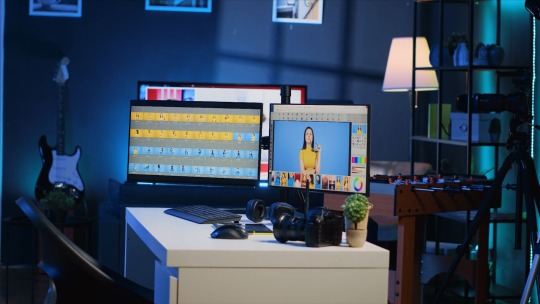
What Is a Workstation?
A workstation is a high-performance computer specifically designed for technical or creative workloads. Unlike general-use desktops or gaming PCs, workstations are optimized for:
Stability over long sessions
Handling large files
Multitasking across heavy software
Future scalability (RAM, GPU, etc.)
Reliability under rendering loads
For Photo Editing Professionals
Common Software Used:
Adobe Photoshop
Lightroom Classic
Capture One
Recommended Configuration:
CPU: Intel Core i7 / AMD Ryzen 7 (8-core minimum)
RAM: 32GB (more if using large RAW files or batch processing)
GPU: NVIDIA RTX 3060 or better (for GPU-accelerated features like Super Resolution)
Storage:
NVMe SSD (for OS and programs)
Separate SSD/HDD for photo libraries
Monitor: IPS panel with 100% sRGB or AdobeRGB
Extra Tip:
Color accuracy is critical. Calibrate your monitor regularly or use a factory-calibrated display like Dell UltraSharp or Eizo ColorEdge.
For Video Editing & Motion Graphics
Common Software Used:
Adobe Premiere Pro
DaVinci Resolve
After Effects
Recommended Configuration:
CPU: Intel Core i9 / AMD Ryzen 9 (12 to 16 cores)
RAM: 64GB (for smooth multitasking with timelines, effects, and exporting)
GPU: NVIDIA RTX 4070/4080 or AMD RX 7900 XT
Storage:
1TB NVMe SSD (OS + apps)
2TB NVMe SSD (working projects/cache)
4TB HDD (archive)
Monitor: Dual displays with one calibrated for video color grading
Must-Have:
Dedicated GPU memory (VRAM) of 8GB or more is vital for 4K+ editing and heavy effects work.
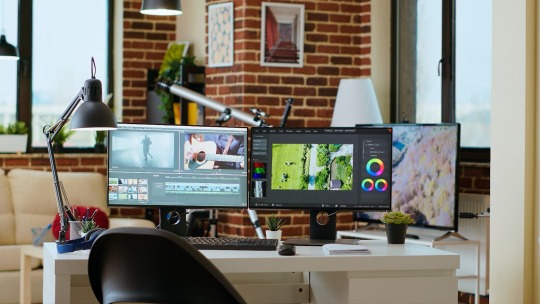
For 3D Modeling, VFX & Rendering
Common Software Used:
Blender
Autodesk Maya
Cinema 4D
Unreal Engine
Recommended Configuration:
CPU: AMD Threadripper / Intel Xeon / Ryzen 9 (16+ cores)
RAM: 64–128GB (depending on scene complexity)
GPU: NVIDIA RTX 4080 / 4090 (CUDA support preferred for rendering engines)
Storage:
1TB NVMe SSD
2TB NVMe SSD for project files and cache
Additional SSD/HDD for textures, assets, backups
Monitor: High-resolution 2K or 4K display with wide gamut
Bonus:
Look for ECC memory and professional GPUs (NVIDIA Quadro or RTX A series) for studios doing long-form 3D and simulation work.
Key Considerations When Choosing a Workstation
1. Software-Centric Planning
Always build around the main software you use. For example:
After Effects = RAM + CPU-heavy
Blender Cycles = GPU-render focused
Photoshop = Scratch disk speed + monitor accuracy
2. Thermal Management
Creative work sessions can go on for hours. Ensure good airflow, quiet fans, and quality cooling systems to prevent thermal throttling.
3. Upgradability
Look for motherboards and cases that support future upgrades:
Extra RAM slots
M.2 SSD slots
Dual GPU support (if required)
4. Power Supply Stability
Use an 80+ Gold PSU (650–1000W depending on GPU) for consistent power under heavy rendering.
Who Needs a Professional Workstation?
Content Creators working on YouTube, documentaries, or commercial videos
Designers in advertising, architecture, and product development
3D Artists working in animation, VFX, or game environments
Photographers managing large raw image libraries
Studios needing reliability across multiple software pipelines
Pre-Built vs Custom Workstations: Which Should You Choose?
Pre-built Workstation: ✔ Ready to go ✔ Reliable support ❌ Less customization ❌ Higher cost per spec
Custom Workstation: ✔ Fully optimized for your specific tools ✔ Better performance-to-price ratio ❌ Needs expertise or guidance
If you're unsure, consult a PC builder who specializes in creative hardware — they can match your budget to the best specs based on your workflow.
Conclusion: Build for Your Creative Flow
A creative professional’s time is valuable. Whether you're editing a cinematic video, refining digital art, or rendering complex 3D environments, the right workstation lets you focus on your creativity — not technical bottlenecks.
So don’t settle for a generic PC setup. Choose a workstation built specifically for your software, workflow, and future needs. It will pay off in speed, stability, and overall satisfaction.
0 notes
Text
The Growing Demand for Animation in Advertising & Other Commercial Industries
In today’s digital-first world, animation has evolved from being just an entertainment medium to a dynamic tool reshaping the way brands, businesses, and industries communicate with their audiences. From creative advertising campaigns to engaging social media content and immersive corporate presentations, animation is leaving its mark across various commercial sectors. As audiences crave visually compelling and interactive experiences, the demand for skilled animators and animation-based content is steadily rising.
Why Animation Is Taking Over Advertising
Advertising has always been about capturing attention and delivering memorable messages. Traditional static ads often struggle in a content-saturated world where digital consumers scroll through information rapidly. This is where animation steps in, offering vibrant, eye-catching visuals and storytelling that leave a lasting impact.
Animated advertisements can simplify complex messages, evoke emotions, and connect with diverse audiences through characters, motion graphics, and storytelling. Whether it’s a 10-second social media ad or a minute-long explainer video, animation makes the content more shareable and engaging. Brands like Google, Coca-Cola, and McDonald’s frequently use animated content in their global campaigns because of its versatility and universal appeal.
Beyond Advertising: Animation’s Role in Other Industries
While advertising remains a key domain, animation’s commercial applications extend far beyond. Several industries have embraced animation to enhance their communication, training, and branding efforts:
Education & E-Learning: Animated tutorials and explainer videos simplify difficult subjects, making learning interactive and accessible for students of all ages.
Healthcare: Medical animations are used to explain complex procedures, showcase how medications work within the body, and support patient education.
Architecture & Interior Design: 3D animations and walkthroughs allow clients to visualize projects before they’re built, improving decision-making and design accuracy.
Real Estate: Virtual tours created through animation offer immersive experiences for prospective buyers, making property showcases more appealing.
Entertainment & Gaming: With the rise of OTT platforms and mobile gaming, animated content is at an all-time high, creating opportunities for creative professionals globally.
Corporate Training & Presentations: Businesses use animated videos to train employees, explain company policies, and present business proposals in an engaging, easy-to-understand format.
The Rise of Animation in Digital Marketing
With social media platforms like Instagram, Facebook, YouTube, and TikTok favoring video content, animated videos have become an essential component of digital marketing strategies. Brands leverage short, quirky animated clips to improve brand recall, explain products, and drive conversions. Additionally, motion graphics and animated infographics make data-heavy content more digestible and shareable.
The affordability and accessibility of animation software have also contributed to this surge. Small businesses and startups now have the tools to create quality animated content without hefty production budgets, leveling the playing field against larger competitors.
Career Opportunities in the Animation Industry
As businesses across sectors increasingly depend on animation for their marketing, education, and operational needs, the demand for skilled animators continues to grow. From graphic designers and motion graphic artists to 3D modelers and VFX specialists, there’s a rising need for creative professionals trained in modern animation tools and techniques.
Moreover, freelancers and animation entrepreneurs are finding lucrative opportunities in content creation, gaming, advertising, and social media marketing.
Start Your Creative Journey with Dreamzone
If you’re passionate about animation and visual storytelling, now is the perfect time to build a career in this dynamic industry. Dreamzone offers the Best Graphic Designing Courses and specialized Animation Courses in Kerala for aspiring creatives. Enhance your skills with practical, hands-on training in Graphics Designing Courses in Kerala and discover the art of transforming spaces with our expert-led Interior Design courses in Kerala.
Start your creative journey today with Dreamzone’s career-ready programs and turn your passion into a thriving profession!
#Best Animation Courses in kochi#Animation Courses in kochi#Animation Courses in Ernakulam#Animation Courses in Kerala
0 notes
Text
Lunar Enterprises – Building Websites & Brands That Drive Results
In the digital age, a great-looking website alone won’t cut it. What your business truly needs is a strategic online presence that converts visitors into leads and leads into loyal customers. At Lunar Enterprises, we specialize in building websites and brands that drive real, measurable results.
Whether you’re a small business in Kerala or an enterprise expanding across India, we bring together smart technology, design, and marketing to help you succeed online.
🌐 Website Development That Works for Your Business
A website is more than just an online brochure—it’s your most powerful marketing tool. At Lunar Enterprises, we design and develop websites that:
Look stunning on all devices (mobile, tablet, desktop)
Are SEO-optimized to rank higher on Google
Offer fast loading speed and user-friendly navigation
Include powerful features like contact forms, lead capture, and eCommerce
Are easy to manage with content management systems like WordPress, Shopify, and custom CMS
From simple landing pages to complex portals, we build websites that generate leads and deliver ROI.
💼 Branding That Makes You Stand Out
Your brand is more than just a logo—it's your business identity. Our branding and design team helps you craft a visual and emotional connection with your audience.
We offer:
Logo Design & Brand Guidelines
Graphic Design for Web, Print, and Ads
UI/UX Design for Web and Mobile Applications
3D Animation & Motion Graphics
Consistent Brand Voice Across All Marketing Channels
Our branding process ensures your business looks professional, trustworthy, and instantly recognizable.
📣 Marketing Strategies That Deliver Results
What good is a great website or brand if no one sees it? That’s why we provide full-scale digital marketing services that help you grow your audience and revenue:
Search Engine Optimization (SEO)
Google Ads & Social Media Ads (Meta, Instagram, LinkedIn)
Content Marketing & Blogging
Social Media Management
Email Campaigns & Lead Nurturing
Each campaign is built around your goals—whether that’s generating leads, increasing sales, or improving brand awareness.
🔍 Data-Driven Approach for Better Decisions
We believe in strategies backed by data. Our services include:
Business strategy planning
Analytics integration and performance tracking
Custom dashboards for marketing, sales, and traffic reports
Ongoing optimization based on insights and KPIs
We help you make smarter decisions and get better results over time.
🛠️ Everything You Need Under One Roof
Lunar Enterprises isn’t just another digital agency. We are a full-service team offering:
Web Development
App Development & Software Solutions
UI/UX & Graphic Design
3D Animation & Visual Branding
Marketing Strategy & Execution
Our holistic approach ensures every piece of your online presence works together toward one goal: results.
🚀 Why Businesses in Kerala Choose Lunar Enterprises
✅ 100% Custom Solutions – Tailored for your industry ✅ Experienced Team – Developers, designers, strategists, and marketers ✅ Proven Track Record – Projects delivered for startups, SMBs, and large enterprises ✅ Transparent Process – From planning to launch and beyond ✅ Local Presence – We understand the Kerala market and beyond
#business strategy#business strategy planning#video games#marketing#employment#management#accounting#webdevelopment#appdevelopment#software development#best services#ui ux design#graphic design#3d animation
0 notes
Text
3D Animation Market Trends: Virtual Production and Real-Time Rendering

The 3D animation market is rapidly expanding, revolutionizing industries like film, gaming, advertising, architecture, engineering, and healthcare. With advanced technologies such as real-time rendering, motion capture, AI, and AR/VR, 3D animation is increasingly becoming a vital component of digital content creation and immersive experiences.
The growth of streaming platforms, interactive gaming, and metaverse ecosystems has significantly increased the demand for high-quality 3D animation. Additionally, the rising adoption of 3D visualization in product design, marketing, and e-learning has expanded the market beyond entertainment.
Market Overview
Key factors driving market growth include:
Increasing demand for realistic visual effects (VFX) in films and gaming.
Adoption of virtual production technologies in the entertainment sector.
Growing use of 3D animation in marketing, product visualization, and simulations.
Expansion of AR/VR-based applications across industries.
The market’s evolution is strongly influenced by cloud-based 3D animation software, enabling remote collaboration and faster rendering capabilities.
Click here to download a sample report
Key Market Drivers
1. Rising Demand for Realistic and Immersive Content The growing expectation for cinematic-quality visuals in films, commercials, and games is fueling the use of 3D animation.
2. Growth of the Gaming Industry The gaming sector, particularly with AAA titles and esports, heavily relies on advanced 3D models and VFX.
3. Integration of AR/VR and Metaverse 3D animation is the backbone of immersive VR experiences, virtual avatars, and interactive digital worlds.
4. Technological Innovations in Software and Tools 3D animation software like Autodesk Maya, Blender, Unreal Engine, and Cinema 4D have advanced capabilities for real-time rendering.
5. Outsourcing and Cost Efficiency Countries such as India, South Korea, and the Philippines have become major outsourcing hubs for animation projects.
Market Segmentation
By Technique:
3D Modeling
Motion Graphics
Rendering
Visual Effects (VFX)
Others (Simulation, Rigging)
By Component:
Software (Autodesk, Blender, Adobe Animate, Houdini)
Hardware (Workstations, Rendering Systems)
Services (Production, Post-Production, Outsourcing)
By Application:
Film & Television
Gaming
Architecture & Interior Visualization
Advertising & Marketing
Healthcare & Medical Simulation
eLearning & Edutainment
Others (Automotive, Aerospace)
By Region:
North America
Europe
Asia-Pacific
Latin America
Middle East & Africa
Regional Insights
North America The largest market due to Hollywood studios, gaming giants, and technology innovation.
Europe Well-established animation and VFX hubs in France, the UK, and Germany, with a focus on independent content and creative productions.
Asia-Pacific Fastest-growing market with outsourcing hubs in India, South Korea, Japan (anime dominance), and China’s booming animation sector.
Middle East & Africa Rising interest in animated advertising and educational content.
Latin America Emerging market with growing digital media production and outsourced services.
Competitive Landscape
The 3D animation market is highly competitive, with global studios, software developers, and production companies driving innovation.
Key Companies Include:
Autodesk Inc.
Adobe Systems Inc.
Pixar Animation Studios (Disney)
DreamWorks Animation (NBCUniversal)
Blender Foundation
Maxon (Cinema 4D)
SideFX (Houdini)
Technicolor Animation Productions
NVIDIA Corporation
Epic Games (Unreal Engine)
Strategic Initiatives:
Collaboration between software companies and studios for real-time rendering.
Increased investment in cloud rendering farms and AI-based animation tools.
Expansion of services for metaverse-ready and immersive content creation.
Technological & Product Trends
Real-Time Rendering Game engines like Unreal Engine and Unity are transforming animation pipelines for films and interactive media.
AI in 3D Animation AI tools automate rigging, facial motion capture, and lip-syncing, reducing production time.
Cloud-Based 3D Animation Enables remote collaboration and faster rendering via cloud computing and virtual workstations.
Metaverse-Ready Assets Demand for 3D avatars, interactive digital assets, and virtual environments is surging.
Challenges and Restraints
High Production Costs: Advanced 3D animation requires expensive software, hardware, and skilled professionals.
Time-Consuming Processes: Rendering and visual effects can delay projects.
Copyright and Piracy Issues: Intellectual property concerns remain a challenge.
Talent Shortages: Skilled animators and technical artists are in high demand.
Future Outlook (2024–2032)
The 3D animation market is expected to grow significantly due to:
Increasing use of 3D content in marketing, VR training, and simulation.
Metaverse and digital twin technology fueling new opportunities.
AI-driven animation workflows enhancing productivity.
Growth of e-learning platforms and healthcare visualization.
By 2032, real-time 3D animation integrated with AR/VR will dominate industries ranging from entertainment to industrial design.
Conclusion
The global 3D animation market is at the forefront of digital storytelling and immersive content creation. Companies that invest in cloud-based pipelines, AI, and interactive technologies will thrive in this dynamic and rapidly evolving market.
0 notes
Text
VFX Basics: Terms and Techniques You Should Know

In today’s digital age, visual effects (VFX) play a crucial role in nearly every film, TV show, commercial, and even video game. From flying superheroes to exploding spaceships and magical landscapes, VFX makes the impossible possible. But if you're new to this world, all the technical terms and software might seem overwhelming.
This article breaks down the basics of VFX, including common terms and techniques, and how you can begin your journey into this fascinating field by enrolling in VFX Prime Courses in Udaipur or specialized VFX Film Making Courses in Udaipur.
What Is VFX?
VFX, or Visual Effects, refers to the process of creating or manipulating imagery that is not possible (or too expensive or dangerous) to capture during live-action filming. VFX artists combine live footage with computer-generated imagery (CGI) to create stunning visuals that bring stories to life.
Unlike traditional special effects (which are done on set), VFX is done in post-production, after the footage is filmed.
Common VFX Terms You Should Know
Before diving into techniques, it's helpful to understand some basic terminology:
1. CGI
CGI refers to images created entirely using computer software. This includes creatures, environments, explosions, and more.
2. Compositing
This is the process of combining multiple visual elements (live footage, graphics, CGI, etc.) into a single scene. It's one of the core skills taught in VFX Prime Courses in Udaipur.
3. Green Screen
A technique where actors are filmed against a green or blue screen, allowing the background to be replaced digitally in post-production.
4. Rotoscoping
This involves manually removing or isolating parts of footage, often frame-by-frame. It’s crucial for clean compositing.
5. Matte Painting
Digital matte painting is the creation of detailed environments or backgrounds (like a fantasy castle or futuristic city) that are added to live footage.
6. Motion Tracking
Used to track the movement of the camera or an object in a shot so that CGI elements can be added seamlessly.
7. 3D Modeling
The process of creating three-dimensional digital objects, characters, or environments. This is fundamental in VFX Film Making Courses in Udaipur.
Key VFX Techniques
Let’s explore some of the most commonly used techniques in the VFX industry:
✅ 1. Digital Compositing
This is where all the visual components—live-action footage, CGI, matte paintings, effects—are combined using software like Adobe After Effects, Nuke, or Fusion.
Compositing helps ensure that everything in a scene looks like it belongs together—lighting, shadows, motion, and perspective must match perfectly.
✅ 2. Particle Effects
Particles are used to create effects like fire, smoke, rain, explosions, or magic dust. Particle simulation software like Houdini or Blender allows for realistic physics-based effects.
✅ 3. Match Moving
This technique involves tracking a moving camera in a scene and recreating that camera movement in 3D software, so CGI can be added to the scene with perfect alignment.
✅ 4. Crowd Simulation
Used in large-scale battle scenes or busy cities, crowd simulation uses AI and animation to populate scenes with hundreds of realistic moving characters.
✅ 5. Cloth and Hair Simulation
For realism, animators simulate how clothing or hair moves based on character motion and environmental factors like wind or gravity.
Software Tools Used in VFX
Some of the industry-standard tools you’ll learn in VFX Prime Courses in Udaipur include:
Adobe After Effects – For compositing and motion graphics
Autodesk Maya – For 3D modeling and animation
Blender – A powerful free tool for modeling, animation, and VFX
Nuke – Professional compositing software used in films
Houdini – For particle effects and dynamic simulations
Cinema 4D – For motion graphics and 3D rendering
Why Learn VFX in Udaipur?
Udaipur is emerging as a growing hub for digital arts and media education. If you're passionate about VFX and want to turn your interest into a career, enrolling in VFX Prime Courses in Udaipur offers a solid foundation in both creative and technical skills.
These courses typically cover:
Fundamentals of design and visual storytelling
Video editing and color correction
Compositing and green screen techniques
3D modeling and animation
Visual storytelling and pre-visualization
Industry workflows and portfolio development
For those interested specifically in the film and entertainment industry, VFX Film Making Courses in Udaipur offer specialized training in cinematic techniques, integrating VFX into storytelling, and preparing students for real-world production environments.
Career Opportunities in VFX
After completing a VFX course, you can explore careers in:
Film and Television
Animation Studios
Game Development
Advertising Agencies
Streaming Platforms (like Netflix, Disney+, etc.)
Popular job roles include:
VFX Artist
Compositor
3D Modeler
Roto Artist
Motion Graphics Designer
Environment Artist
FX Artist
As demand for high-quality content continues to rise, skilled VFX professionals are increasingly sought after across the globe.
Final Thoughts
Visual effects are no longer just about Hollywood blockbusters—they're a core part of how we tell stories, sell products, and create immersive experiences across all types of media.
Whether you're interested in working on movies, designing eye-catching ads, or animating your own creations, learning VFX opens a world of creative possibilities.
If you're serious about mastering the craft, consider enrolling in VFX Prime Courses in Udaipur or specialized VFX Film Making Courses in Udaipur to gain hands-on experience, expert guidance, and the skills you need to launch a successful career in visual effects.
0 notes